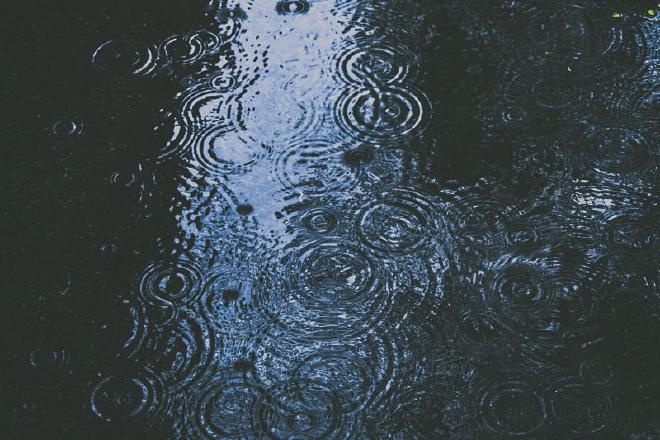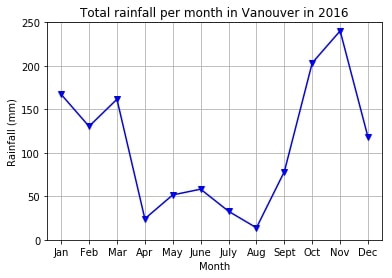Raincouver

The following code stems from a project I prepared while studying in Vancouver. As it was very, very rainy, I decided to analyze some weather data, trying to answer if there was reason to be optimistic for the months to come.
The data is official governmental weather data, measured at the weather station at the international airport in the year 2016, and contains information about the weather in Vancouver in 2016 (date, temperature, rainfall, snowfall, direction of the wind, …). It can be downloaded here here.
The idea was to plot monthly rainfall. From the information available, all that I needed to solve the problem was the rainfall (mm) and the month.
from typing import List, NamedTuple
from matplotlib import pyplot
import csv
Weather = NamedTuple('Weather', [('month', int), # in range (>0)
('rainfall', float)]) # in range (>0)
# interp. a day with its month and rainfall (mm)
W1 = Weather(1, 0.0)
W2 = Weather(11, 31.0)
W3 = Weather(12, 1.2)
W4 = Weather(12, 7.2)
# template based on compound
def fn_for_weather(w: Weather) -> ...:
return ...(w.month,
w.rainfall)
# List[Weather]
# interp. a list of weather data
LOW0 = []
LOW1 = [W1, W2]
LOW2 = [W1, W2, W3, W4]
# template based on arbitrary-sized and the reference rule
def fn_for_low(low: List[Weather]) -> ...:
# description of the acc
acc = ... # type: ...
for w in low:
...(acc, fn_for_weather(w))
return ...(acc)
def main(filename: str) -> None:
"""
Reads the file from given filename and creates a line chart showing the total rainfall (mm) per month
"""
# template based on function composition
return plot_line_chart(read(filename, 26))
def read(filename: str, num_header_rows: int) -> List[Weather]:
"""
Reads information from the specified file and returns a list of weather data (month and rainfall)
Skips the first num_header_rows rows.
"""
# low contains the result so far
low = [] # type: List[Weather]
with open(filename) as csvfile:
reader = csv.reader(csvfile)
# the current line in the input file
line = 0 # type: int
for row in reader:
line = line + 1
if line > num_header_rows:
# if we reach this point, we are past the header rows
month = parse_int(row[2])
rainfall = parse_float(row[15])
# only read lines without any missing values
if is_valid_month(month) and is_valid_rainfall(rainfall):
w = Weather(month, rainfall)
low.append(w)
return low
def is_valid_month(month: Optional[int]) -> bool:
"""
return False if month is None and True otherwise
"""
# return True # stub
# template based on one-of (2 cases), atomic distinct and atomic non-distinct
if month is None:
return False
else:
return True
def is_valid_rainfall(rainfall: Optional[float]) -> bool:
"""
return False if rainfall is None and True otherwise
"""
# return True # stub
# template based on one-of (2 cases), atomic distinct and atomic non-distinct
if rainfall is None:
return False
else:
return True
def plot_line_chart(low: List[Weather]) -> None:
"""
Displays a line chart of the daily rainfall per month in low over time
"""
# return None # body of the stub
# set properties of your chart
pyplot.xlabel("Month")
pyplot.ylabel("Rainfall (mm)")
pyplot.title("Total rainfall per month in Vanouver in 2016")
pyplot.axis([0.5, 12.5, 0, 250])
plt.grid()
# plot our data
x_values = month_list(low)
y_values = rainfall_list(low, x_values)
line = pyplot.plot(x_values, y_values)
# set the labels for each 'tick' on the x-axis
tick_labels = ["Jan", "Feb", "Mar", "Apr", "May", "June", "July", "Aug", "Sept", "Oct", "Nov", "Dec"]
plt.xticks(x_values, tick_labels)
# set properties of line
pyplot.setp(line, color='b', marker='v')
# show plot
pyplot.show()
def month_list(low: List[Weather]) -> List[int]:
"""
Creates a list of ints that represent the months in low
Assumption: months are in order
"""
# return [] # List[int]
# template from List[Weather]
# acc will hold the distinct months seen so far
acc = [] # Type: List[int]
# previous_element holds the information of the previous element
previous_element = Weather(0, 0.0)
for w in low:
if not same_month(w, previous_element):
acc.append(return_month(w))
previous_element = w
return acc
def same_month(w1: Weather, w2: Weather) -> bool:
"""
Returns True if the months of w1 and w2 are the same, False otherwise
"""
# return True # stub
# template based on Weather
return same_int(return_month(w1), return_month(w2))
def same_int(m1: int, m2: int) -> bool:
"""
Returns True if m1 equals m2, False otherwise
"""
# return True # stub
# template based on atomic non-distinct
return m1 == m2
def return_month(w: Weather) -> int:
"""
returns the corresponding int for the month of w
"""
# return 0 # stub
# template based on Weather
return w.month
def rainfall_list(low: List[Weather], month_list: List[int]) -> List[float]:
"""
Creates a list of floats that represent the rainfall in each month of month_list
"""
# return [] # List[int]
# template from List[Weather]
# acc will hold the total rainfall for each month
acc = [] # Type: List[float]
for m in month_list:
acc.append(rainfall_per_month(low, m))
return acc
def rainfall_per_month(low: List[Weather], month: int) -> float:
"""
Returns the total rainfall for the given month
"""
# return 0.0 # Stub
# template from List[Weather]
# acc will hold the total rainfall of the days seen so far
acc = 0.0 # Type: float
for w in low:
if same_int(return_month(w), month):
acc = acc + return_rainfall(w)
return acc
def return_rainfall(w: Weather) -> float:
"""
returns the corresponding float for the rainfall of w
"""
# return 0 # stub
# template based on Weather
return w.rainfall
# Begin testing
start_testing()
# Examples and tests for main
expect(main('daily_weather_2016.csv'), None)
# Examples and tests for read
expect(read('daily_weather_2016_test1.csv', 26), [Weather(1, 0.0), Weather(1, 0.0)])
expect(read('daily_weather_2016_test2.csv', 26), [Weather(7, 7.8), Weather(10, 1.2)])
# Examples and tests for is_valid_month
expect(is_valid_month(None), False)
expect(is_valid_month(1), True)
expect(is_valid_month(2), True)
# Examples and tests for is_valid_rainfall
expect(is_valid_rainfall(None), False)
expect(is_valid_rainfall(1.0), True)
expect(is_valid_rainfall(22.0), True)
# Examples and tests for plot_line_chart
expect(plot_line_chart(read('daily_weather_2016.csv', 26)), None)
# Examples and tests for month_list
expect(month_list([Weather(1, 0.0), Weather(1, 0.0)]), [1])
expect(month_list([Weather(7, 7.8), Weather(7, 7.8), Weather(10, 1.2)]), [7, 10])
expect(month_list([Weather(7, 7.8), Weather(7, 7.8), Weather(7, 1.2)]), [7])
expect(month_list(read('daily_weather_2016.csv', 26)), [1, 2, 3, 4, 5, 6, 7, 8, 9, 10, 11, 12])
# Examples and tests for return_month
expect(return_month(Weather(1, 0.0)), 1)
expect(return_month(Weather(2, 0.0)), 2)
# Examples and tests for same_month
expect(same_month(Weather(1, 0.0), Weather(2, 0.0)), False)
expect(same_month(Weather(2, 0.0), Weather(2, 0.0)), True)
# Examples and tests for same_int
expect(same_int(1, 1), True)
expect(same_int(2, 3), False)
# Examples and tests for rainfall_list
expect(rainfall_list(LOW1, [1]), [0.0])
expect(rainfall_list(LOW1, [1, 11]), [0.0, 31.0])
expect(rainfall_list(LOW1, [1, 11, 12]), [0.0, 31.0, 0.0])
expect(rainfall_list(LOW2, [1, 11, 12]), [0.0, 31.0, 8.4])
expect(rainfall_list(LOW2, [1, 2, 3, 4, 5, 6, 7, 8, 9, 10, 11, 12]), [0.0, 0.0, 0.0, 0.0, 0.0, 0.0, 0.0, 0.0, 0.0, 0.0, 31.0, 8.4])
# Examples and tests for rainfall_per_month
expect(rainfall_per_month(LOW1, 1), 0.0)
expect(rainfall_per_month(LOW1, 2), 0.0)
expect(rainfall_per_month(LOW1, 11), 31.0)
expect(rainfall_per_month(LOW1, 12), 0.0)
expect(rainfall_per_month(LOW2, 12), 8.4)
# Examples and tests for return_rainfall
expect(return_rainfall(Weather(1, 0.0)), 0.0)
expect(return_rainfall(Weather(2, 2.0)), 2.0)
# show testing summary
summary()
[32 of 32 tests passed]
Here is the final result. I lived in Vancouver from January until April, so indeed, it got better in the end. Based on the plot, it would have gotten even better afterwards. Still, I have never lived in a place where it rains so much as in Vancouver, BC.

Get the full code here.